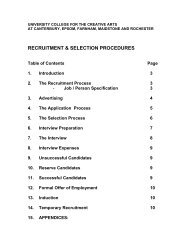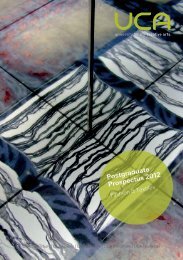John Hinchcliffe
John Hinchcliffe
John Hinchcliffe
- No tags were found...
You also want an ePaper? Increase the reach of your titles
YUMPU automatically turns print PDFs into web optimized ePapers that Google loves.
a successful line. <strong>Hinchcliffe</strong> and Barber worked with the Poole Pottery onone other project, which resulted in a very small trial production of waresdesigned in 1989 but never made commercially. The Atrium range is atypical.It was commissioned from the furniture designers G Plan who were seeking tocreate a range of signature ceramics to embellish new black wood and chromefurniture. The pots had a plain angular style new to <strong>Hinchcliffe</strong>’s work. Thematt colour used for the Atrium pots (turquoise green and terracotta-red)were related to the first monochrome green Poole ceramics. They weretypically 1980s ‘designer ceramics’, professionally and clinically produced,but without the warmth and sociability of the customary work.The studio ware at Sixpenny Handley reached a high standard. This was aprolific and confident period for the makers. Ideas matured as they developedon the ware itself, and the small team of talented assistants kept a close eye onstandards. The work characteristically had a sponged background, with a livelypalette of colours: reds, yellows, greens and grey black predominate. Animal,fish and bird imagery was used, with studio assistants as well as <strong>Hinchcliffe</strong> andBarber all contributing. The vine leaf pattern achieved notable success, a moresubtle and restrained motif than the ever popular Hypericum. A tulip designaround a deep blue ‘speckled-sponge’ border and bowl made an appearance. TheSteeplechase pattern was introduced, with confident riders and horses gallopingacross the plates, alluding both to the studio’s rural location and the tradition ofearly 19th century engravings. All of this imagery was uncomplicated and usednaturalistic motifs in a way that celebrated the spontaneity of hand painting.These ceramics looked good in the 1980s urban kitchen (whether in Islingtonor Shaftesbury) where either the French provincial, scrubbed-pine lookprevailed, or that fostered by smaller, design-conscious specialist manufacturersfeaturing the extensive use of expensive woods. The partnership marketed thestudio’s work to emphasise the look that managed to be both sophisticatedand unpretentious. To complete the rural idyll image (as seen by urban readersin numerous interior design magazines) the vases were filled exuberantly withfresh, country flowers to complement the poised wooden furniture and theterracotta or flagstone floors. These magazines constantly used the studio’sdesigns to create the desirable ‘country-kitchen’ effect for metropolitansdreaming of their weekend retreat to the country. The <strong>Hinchcliffe</strong> and Barberlook enlivened the iroko worktops and double butler sinks of the 1980s middleclass kitchen. <strong>Hinchcliffe</strong> was to say that ‘our designs move easily from thekitchen to the dining room and we try to produce something that would blendin with antiques. The look we like is a blend of old and new’. 39A second commercial partnership was developed in this period with theHoniton Pottery, Devon, which needed a biscuit ware provider for their studioranges. The production of some of the pots developed at Poole was transferredto Honiton in 1987, though the Honiton Pottery did not, initially, market thestudio ware. The concept was to produce sufficiently large quantities of a‘designer range’ to complement the more highly decorated studio wares. Atthis time, too, the makers explored the idea of producing kitchen furniturespecifically to complement their ceramics. They designed dressers in atraditional style but given a modern edge by a finish of soft colour washes.Stools, chairs and tables were added. The simple pine furniture foreshadoweda vogue in the period for Shaker style furniture with its emphasis on quality ofwood and honest simplicity of design, perfectly fit for function. The furniturewas made by Clive Frampton at a workshop in Sixpenny Handley next totheir own studio.An important indicator of the national recognition of the studio’s work (andits commercial derivatives) was announced in 1987-88 when the company32 J o h n H i n c h c l i f f e J o h n H i n c h c l i f f e 33
















